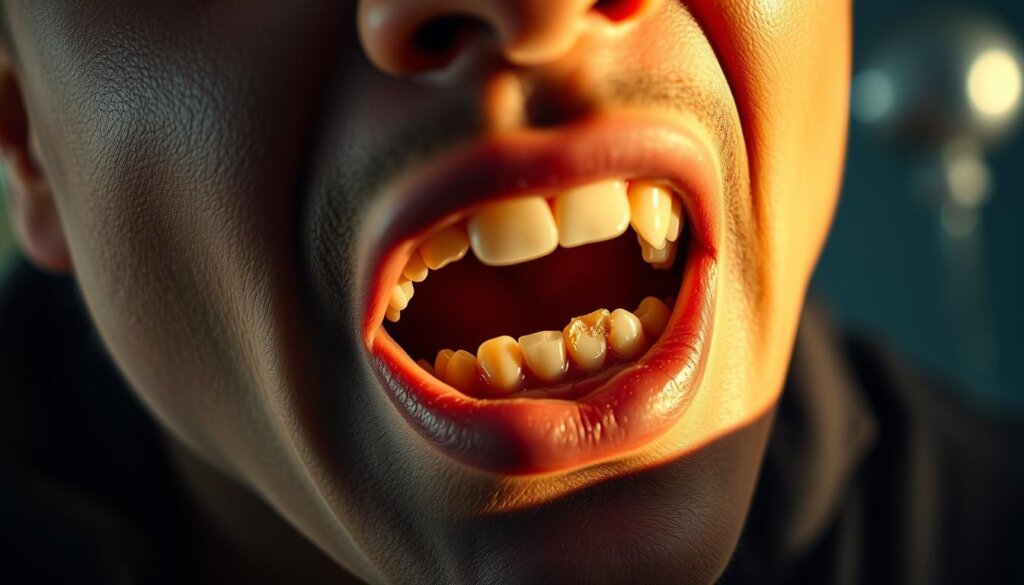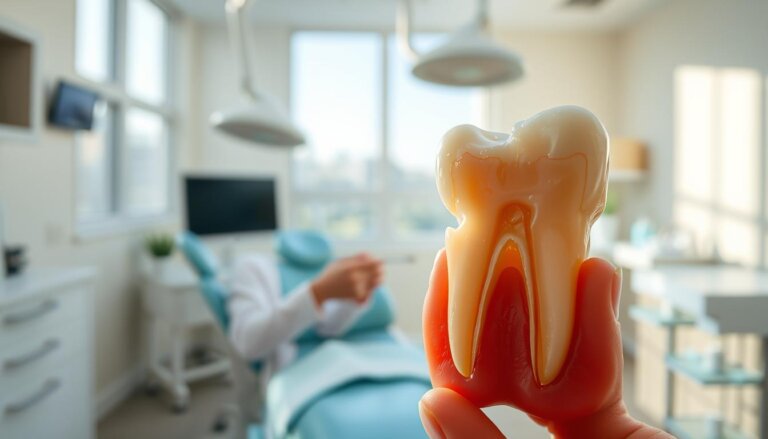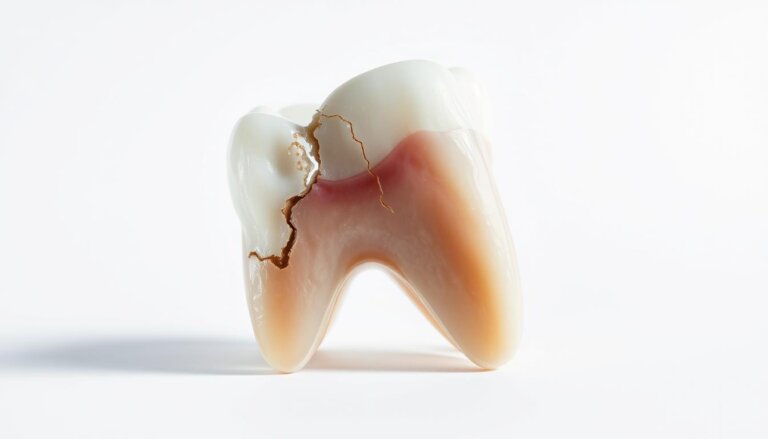Immediate Action Needed: Broken Tooth Repair Timing
A study by the American Dental Association shows over two million people in the U.S. break a tooth each year. Even small cracks can cause big problems if not fixed right away. They can lead to pain, infection, and even tooth loss.
Many wonder, “How long can I wait to fix a broken tooth?” Dentists say you should get help fast. A small chip can expose the tooth’s inner layers. Quick action helps avoid bigger issues and keeps your teeth healthy.
Key Takeaways
- Prompt repair lowers the risk of infection.
- Even small cracks can jeopardize tooth structure.
- Early treatment saves time and money.
- Consult a dental professional to rule out nerve involvement.
- Delaying repair can cause ongoing pain.
- Regular check-ups help prevent severe damage.
Understanding Broken Teeth
Teeth can crack or fracture under sudden stress. Enamel, though strong, can weaken from daily wear or hidden decay. A minor chip might only affect the outer layer, yet deeper damage can penetrate the pulp and compromise tooth stability. This context highlights why a broken tooth repair timeline is so important.
Ignoring these injuries can make them worse. Tiny fractures might seem okay at first, but severe splits can lead to infection and pain. Why risk it?
Common Causes of Broken Teeth
Many factors can weaken dental structures:
- Repeated biting on hard candy or ice
- Untreated cavities compromising the enamel
- Sudden trauma from sports or accidents
Types of Dental Fractures
Dental experts classify fractures by severity and location:
- Minor Chip: Only involves enamel
- Moderate Crack: Extends through dentin and may reach the pulp
- Severe Split: Extends below the gumline and often causes root complications
| Fracture Level | Possible Action |
|---|---|
| Surface Chip | Bonding or simple filling |
| Deep Crack | Root canal or crown placement |
Signs You Need Immediate Dental Attention
Dental problems can sneak up on you. Cracks or chips can lead to infection and damage. Our team urges you to see us fast if you notice any signs.

Persistent pain could mean a bigger issue. Trouble chewing is a sign of serious damage. Catching problems early can prevent tooth loss and abscesses.
Persistent Pain and Discomfort
Constant aches or sharp pains mean nerves are at risk. Ignoring trauma can lead to needing a root canal. Quick action is key to keeping your teeth working right.
Visible Damage to the Tooth
Big cracks or chips let bacteria in, threatening your gums. If dentin is exposed, you might feel pain from hot or cold. Seeing us fast can save your enamel and prevent bigger problems.
| Key Sign | Potential Hazard |
|---|---|
| Throbbing Pain | Possible nerve damage |
| Major Fracture | Increased abscess risk |
| Deep Sensitivity | Enamel erosion |
Risks of Delaying Tooth Repair
Untreated fractures open doors for bacteria. This can lead to severe pain in the pulp chambers. If swelling gets worse, it could turn into a dental emergency broken tooth.
Getting help early is key to protect your teeth and health.
Increased Risk of Infection
Exposed surfaces let bacteria move deeper. This can cause intense pain and swelling in the jaw. In some cases, abscesses form, affecting nearby tissues.
Quick treatment stops bacteria from spreading. This can save you from expensive treatments later.
Potential for Tooth Loss
Ignoring a fracture can weaken the tooth. This increases the risk of losing the tooth. It can also affect how you chew and speak.
Fixing the tooth early keeps it functional. It also avoids the stress of having to get it extracted.
When to Seek Emergency Care
A broken tooth can quickly turn into a serious issue. If you feel intense pain, sudden swelling, or heavy bleeding, you need urgent care. Getting help fast can prevent more problems.
Knowing when to seek help is key to keeping your teeth healthy. Experts can provide the right treatment and care.
Signs of Severe Complications
Severe pain that spreads to your jaw or throbs is a big warning sign. Swelling, fever, or trouble breathing are also urgent signs. Jaw stiffness and ongoing bleeding mean you need help right away.
How to Find an Emergency Dentist
Finding a good emergency dentist involves a few steps:
- Check local dental association websites for trusted clinics.
- Ask friends or family for recommendations.
- Look in official healthcare directories for emergency dentists.
Acting quickly can help avoid bigger health issues and ensure a better recovery.
Temporary Solutions for Broken Teeth
Many people look for quick fixes to ease pain when they can’t see a dentist right away. Over-the-counter gels or tablets can help with broken tooth pain management. They reduce swelling and protect against more irritation. Covering the broken area with protective materials also helps keep it safe.
Dental Wax and Temporary Fillings
Dental wax or a temporary filling can protect the damaged tooth from pressure. These solutions help keep the tooth stable until a dentist can fix it for good. Some people use special products to smooth out sharp edges, which helps prevent further damage.
Avoiding Hard Foods
Hard foods like crunchy snacks or firm fruits can make a crack worse. Eating soft foods like cooked veggies, eggs, and blended soups is better. It reduces jaw pain and keeps the tooth in place. Staying away from hard foods helps avoid making the problem worse.
Treatment Options for Broken Teeth
Getting a broken tooth fixed quickly is key. Dentists use different methods to fix and keep your teeth healthy. The choice depends on how bad the break is and where it is.
Bonding and Fillings
Small chips can often be fixed with bonding or fillings. These methods use a tooth-colored resin to fix the tooth. The dentist etches the area, applies a bonding agent, and shapes the resin. Then, they use a light to harden it.
Crowns and Veneers
Bigger breaks need stronger fixes. Crowns cover the whole tooth to prevent more damage. Veneers are thin porcelain shells for the front of the tooth to hide flaws and strengthen it. Both options aim to make the tooth stable and look natural.
Root Canals
If the break goes into the pulp, a root canal might be needed. This removes infection risks. After, a strong crown is placed to keep the tooth safe and comfortable for a long time.
| Treatment | Ideal For | Key Benefit |
|---|---|---|
| Bonding & Fillings | Small Chips | Quick Aesthetic Repair |
| Crowns & Veneers | Moderate Fractures | Enhanced Protection & Appearance |
| Root Canal | Deep Damage | Preserves Natural Tooth Structure |
Factors Affecting Repair Timing
Fixing a broken tooth depends on several things. How bad the break is and how well you take care of your teeth can affect the time needed. Everyone’s situation is different, so the fix time varies.
Brushing and flossing daily keeps your gums healthy. This makes dental work easier. But, smoking can slow down healing, so it’s important to be careful.
Severity of the Damage
Big cracks need quick action. Small chips might wait a bit, but deep ones can lead to infection if not fixed fast. Each case needs a close look to find the best fix.
Oral Health and Hygiene
Good home care helps keep the tooth stable before fixing it. Regular rinsing with antibacterial mouthwashes helps fight bacteria. Dentists also say to fix gum problems first to help the tooth heal better.
| Factor | Impact on Treatment |
|---|---|
| Fracture Depth | Urgent care needed for extensive cracks |
| Oral Hygiene | Strong protective barrier fosters faster recovery |
| Tobacco Use | Reduces gum health and prolongs healing time |
Cost Implications of Delaying Repair
Putting off tooth repair can lead to bigger financial problems. If oral health worsens, you might need more expensive treatments. Experts say fixing teeth quickly helps save money and keeps them healthy.
Emergency Procedures vs. Routine Care
Waiting too long can lead to costly emergency visits. These often come with high prices. Advanced problems might need root canals or tooth removal, adding to the cost.
Regular dental visits are cheaper and more predictable. They catch small issues before they become big problems. This can save you from expensive treatments later on.
Insurance Coverage for Dental Repairs
Understanding your insurance is key to knowing what’s covered. Some plans help with crowns, fillings, or root canals. Others have yearly limits. Early treatment usually fits within these limits, avoiding unexpected costs.
Fixing teeth early can prevent more expensive emergencies. This approach keeps your teeth healthy and your wallet happy.
What to Expect During a Dental Visit
A dentist starts by talking with you about your symptoms, medical history, and any tooth pain. This chat helps them understand what you need and plan your visit. It prepares you for a detailed check-up.
Initial Evaluation Process
The dental team looks at your tooth’s outside to see any damage. They also check your gums and the area around your tooth for signs of inflammation. They ask about your pain to understand the problem better.
They also ask about habits like grinding your teeth or past dental work. This information helps them make a more accurate diagnosis. Then, they plan the best course of action for your treatment.
Diagnostic Imaging
They use special tools to find cracks or fractures that aren’t visible. X-rays show how strong your tooth roots are. 3D scans give even more detailed information.
This helps the dentist decide the best treatment for you. It could be a direct fix or a step-by-step plan to get your teeth healthy again.
Preventive Measures for Future Dental Care
Keeping your teeth strong means you need fewer urgent dental visits. A good plan helps avoid problems like cracked enamel or big procedures. Taking care of your teeth now helps keep them healthy for the future.
Regular Dental Check-Ups
Regular dental visits catch small problems early. Dentists fix these issues quickly to avoid bigger problems later. Most dentists suggest going every six months. Some people might need to go more often, depending on their dental history.
- Thorough cleanings remove stubborn plaque
- Exams reveal hidden cracking or decay
- Professional advice covers home care updates
Maintaining Good Oral Hygiene
Brushing twice a day with care helps keep your teeth clean. Use interdental cleaners for tight spaces. Flossing after meals helps keep your teeth and gums strong. This keeps your enamel healthy and prevents sudden tooth problems.
| Technique | Primary Benefit |
|---|---|
| Frequent Check-Ups | Prompt identification of early concerns |
| Proper Brushing | Elimination of plaque along gum lines |
| Flossing | Prevention of decay between teeth |
Lifestyle Changes to Protect Your Teeth
Keeping your teeth strong starts with making smart choices. These choices help avoid damage to your teeth. Many dentists say that small changes each day can stop tooth breaks and save you money.
Stress can lead to bruxism, where you grind your teeth. This weakens them and causes small cracks. Wearing a custom mouthguard helps absorb stress and prevents bigger cracks.
Diet Modifications
Eating foods rich in nutrients helps strengthen your enamel. Avoiding sticky candies and sugary drinks reduces acid. Eating crisp fruits and veggies is good for your gums and gently cleans your teeth.
Avoiding Harmful Habits
Chewing ice or biting your nails puts extra pressure on your teeth. This increases the chance of a tooth breaking. Stopping these habits helps protect your enamel. Deep breathing can help relax your jaw and facial muscles.
“Gentle lifestyle shifts can be the key to avoiding sudden dental crises.”
| Practice | Primary Benefit |
|---|---|
| Opt for Softer Snacks | Reduces tooth strain |
| Use Night Guards | Protects against bruxism |
Myths About Tooth Repairs
Many think pain is the only sign of a broken tooth. This makes people wait too long to see a dentist. Even small cracks can harm your teeth.
Some try home fixes, thinking they can fix a tooth with homemade glue. But, these methods can make things worse, leading to infections.
“The American Dental Association notes that untreated tooth fractures often worsen without professional care.”
Misconceptions About Pain
Pain can come and go, making people think it’s okay if it stops. But, deep problems can hide until it’s too late. Seeing a dentist early is key.
Beliefs About Home Remedies
Using untested fixes or too much clove oil might hide the problem. But, a dentist can find hidden cracks. Quick action can save your tooth.
Post-Repair Care
Keeping a newly fixed tooth in good shape takes a lot of effort. It’s important to take good care of it at home and see your dentist regularly. This helps keep the tooth stable and prevents sudden pain or sensitivity.
Tips for Recovery
After a quick fix for a broken tooth, eating soft or lukewarm foods is best. Using antiseptic mouthwashes can also help keep the area clean. Be gentle when brushing around the fixed area to remove plaque or debris.
- Avoid biting into hard foods until any swelling subsides
- Rinse with mild solutions to keep the area free of bacteria
- Pay attention to any unusual sensitivity during daily activities
When to Follow Up with Your Dentist
Seeing your dentist regularly is key to checking on the tooth’s healing. It helps catch any small problems early. This ensures your tooth stays comfortable and healthy over time.
Conclusion: Prioritizing Dental Health
Acting quickly when a tooth cracks can stop pain and prevent bacterial issues. This move is backed by the American Dental Association. They say early treatment leads to better results in the long run.
Importance of Timely Repairs
Dentists stress that waiting makes fixing a broken tooth harder. Early fixes avoid more pain and cost later. Damaged enamel can lead to infections or tooth loss if not treated right away.
Quick action helps keep your mouth healthy. It also keeps your teeth strong and looking good.
Long-Term Benefits of Immediate Action
Seeing a dentist fast can mean less time healing. Early treatment keeps gums healthy and your teeth in good shape. It’s key for comfort, function, and looks.
By fixing problems quickly, you protect your smile. This keeps your teeth strong for years to come.


